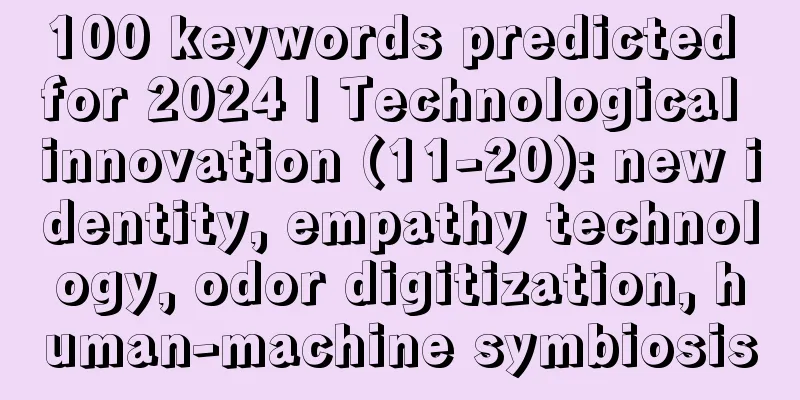100 keywords predicted for 2024 | Technological innovation (11-20): new identity, empathy technology, odor digitization, human-machine symbiosis

In 2024, the Dragon's Journey begins! Every Spring Festival, Wunderman's "2024 Future Trends 100" is released. The report is based on 10 sections, 100 forward-looking keywords, and nearly a thousand innovative cases, making it the world's most valuable trend forecast report every year. The entire report consists of 10 sections: "Culture", "Technology and Innovation", "Tourism and Vacation", "Brand and Marketing", "Food and Beverages", "Beauty", "Retail and Business", "New Luxury Life", "Health", and "Work", with 100 keywords and 100,000 words. "Chapter 1: Culture (01-10): Softness, Connection and Community" We saw the top 10 keywords: 01 "Emotional Value", 02 "Collective Warmth", 03 "Life in a New Climate", 04 "New Etiquette", 05 "Prosocial Activities", 06 "Slowing Trends", 07 "The Beauty of Short-lived Flowers", 08 "Ludd Model", 09 "Natural Human Rights", and 10 "Co-living Community". Today, let’s learn about the second article, “Technology and Innovation”. Part 2: “Technology and Innovation” The 10 keywords in the “Technology and Innovation” section are: 11 “New Identity Economy” 12 “Digital Space” 13 “Empathetic Technology” 14 “Gesture Language” 15 “Elderly Intelligence” 16 “Digitalization of Smell” 17 “Full Language Technology” 18 “Super Charging Destination” 19 “Human-Machine Symbiosis” 20 “Artificial Intelligence Workforce”. 1. New identity economy - a new economy formed around digital charactersIn November 2023, the Hollywood actors' strike ended after 118 days. The SAG-AFTRA union celebrated new measures to protect performing talents, including guidance on the use of artificial intelligence (AI) in the film industry. One important provision is that studios must obtain the consent of actors and compensate them for the use of their digital reproductions or any characteristics. Some actors, including Anil Kapoor, Scarlett Johansson and Tom Hanks, have taken legal action to prevent the unauthorized use of their AI-powered likenesses. While the legal framework is not yet fully established, this puts us on the path to a new economy around human identity. One of the emerging services is the personal image creation service, which allows anyone to create a digital double of themselves. For content creators and influencers, digital avatars can offer unprecedented reach and scale. Chinese influencers are leading the way, commissioning lifelike AI clones to maximize their livestreaming output, creating and earning content 24/7. A range of Chinese startups, such as Silicon Intelligence and Xiaoice, can now create deepfake avatars for as little as $1,000, using just one minute of live original video to generate a digital clone. Metaphysic, a British AI startup that shot to fame for its highly realistic deepfakes of actor Tom Cruise, is helping celebrities take control of their virtual avatars. Their Metaphysic Pro solution allows users to build a range of biometric data that can be used to create faces, voices, and performances, which can then be licensed and used commercially. San Francisco startup Mimio.ai is building a "personality engine" that will allow users to create their own AI avatars that adopt their voices, intonations, and conversational styles. The company foresees applications not just for celebrities and influencers, but for anyone who might need help handling email exchanges, or even for elders who want to leave behind a digital self for posterity. The company promises that users will have full control over their avatars and can monetize them as they wish. It seems inevitable that digital clones will become part of our daily lives. For now at least, flesh-and-blood humans retain the upper hand when it comes to artistry. While ethical and legal guidelines are still being defined, the identity economy is already thriving. Digital characters offer brands a cost-effective and flexible way to attract talent, but it’s worth noting that people still hold a high status in the minds of audiences. Less than one in ten (8%) respondents said they expect virtual people to become part of their daily lives. 2. Digital space - blur and fusion!As spatial computing power advances, the physical and digital worlds will continue to become more integrated.
At CES 2024, Tom Emrich, Niantic’s director of product for AR platforms, predicted that the contextual advantages of smartglasses and headsets will make the smartphone the “assistant” and “hub of all wearables.” Emrich believes that "the spatial technology category is only just forming. This means that it presents a huge opportunity for app developers, web developers, brands and retailers, in particular, to get a foothold". He adds: "I agree with Tim Cook - the era of spatial computing is here, and we are just getting started". As immersive technology continues to advance and the physical and digital worlds become more closely connected, spatial computing will see significant growth, with the market expected to grow from $97.9 billion in 2023 to $280.5 billion in 2028, according to MarketsandMarkets. 3. Empathy technology - comprehensive multi-sensory mobilization and experience!Creators are using technology to explore the relationship between our senses. The fascinating synergy and interplay between our various senses is the theme of a new wave of technology-driven empathetic experiences.
In addition to their art, UK artist collective Universal Everything is putting their synaesthesia skills and experience to work by developing a prototype device that patients can use to visualise pain. In Japan, NTT Docomo and partner organizations are developing the world’s first sensory sharing technology that allows users to digitally send movements or touch. Docomo has plans to build on its Feel Tech technology to enable sharing of other senses such as taste, hearing, and even emotions. The demand for sensory experiences is huge. According to a survey conducted by VML Intelligence for our “The Age of Reinvention” report, 63% of consumers want brands to provide them with multi-sensory experiences, and 72% of consumers said they want to engage as many of their senses as possible when experiencing new things. "Empathy technology" adds a new layer of charm to physical and digital sensory experiences! 4. Sign language - no contact and no gestures!New touchless gestures allow consumers to connect devices more seamlessly.
As tech devices become more integrated into consumers' lives, companies are pushing the boundaries to make them more intuitive and instinctive to use. At the same time, these hands-free gestures are crucial for people with limited mobility, which makes tech companies' products and services more inclusive, as just over 12% of adults in the U.S. have limited mobility, according to the CDC. 5. Intelligence for the Elderly – Intelligent technology meets the lifestyle and health needs of the elderly.For a growing number of older adults, smart technology may be the key to independent living. At the Consumer Electronics Show (CES) in January 2024, we saw many new devices and technologies that can provide greater comfort, safety, and emotional support for elderly people living at home.
The rise of big-speaker models has brought about a new wave of devices that offer not only functionality but also conversation and companionship.
Another focus is facilitating connections to the wider world, whether that’s access to an extended community of ElliQ users or help with local information and transportation. ElliQ’s goal, Soffer says, is to “understand, enrich, and strengthen relationships — and relationships make your life better. Whatever we can do to help you in the real world, we want to do more.” According to the World Health Organization, by 2030, one in six people worldwide will be over 60 years old. As the global population ages, there is a lot of room for technology to meet the emotional and support needs of this growing group. (For more on this, see keyword “92 The Future of Centenarians” (p. 227). 6. Digital Smell – The future of smell is digital!Vision and hearing have been successfully digitized, but what about smell? Osmo is a company working to answer that question. The digital olfaction startup wants to “give computers the sense of smell.” A spinout from Google Research, Osmo’s goal is to create digital representations of smell, changing the way we capture, transmit, and remember scents.
In addition to Osmo, Japan's Revorn also uses artificial intelligence and IoT technology to reproduce smells and imitate olfaction. At the 2024 Consumer Electronics Show (CES), the company exhibited a smell sensing and reproduction device. Luxury perfumers are also exploring digital scents. In March 2023, Bulgari launched “Scentsorial” in Dubai, an immersive multi-sensory experience that combines technology with smell. Participants wear wearable devices that measure their brain waves and heart rate to detect their reactions to the scent, thoughts, and emotions, which are then translated into downloadable generative collectibles in real time. Advances in technology are changing the way we experience and understand smells, driving the development of digital sensory toolkits and bringing us one step closer to true multi-sensory digital experiences, like the Sensory Technology Desktop (see later). 7. All-language technology - instant translation tools create a global village.Artificial intelligence software unlocks language power in nearly any language. In the fall of 2023, a demonstration video circulated on social media, featuring celebrities such as Emma Chamberlain, Elon Musk and Marques Brownlee speaking various languages with cloned versions of their own voices, with their mouth movements translated and synchronized in real time.
Such translation technology unlocks for the first time the potential for accelerated revenue growth for brands, content creators, and educators—organizations and individuals with global audiences. YouTube star Mr. Beast is known for his multilingual strategy. He hires native speakers to dub his videos and translate them into multiple languages. In 2023, he tested YouTube's internal translation tool on 11 of his popular videos and told YouTube's Creator Insider that it "made the videos perform much better." Now, these influencers no longer need to run multiple language channels, they only need to translate the content of one channel. Another online creator, Adam Waheed, told Fortune magazine that he hopes to use AI translation to triple his audience. Spotify is also now piloting AI translations for podcasts, providing a more realistic multilingual experience than voiceovers. These translations are available for select podcasts from people like Steven Bartlett and Lex Fridman, and will be expanded over time. For companies and brands, AI translation will usher in a new era of global engagement, enabling them to speak to any audience without the cumbersome translation process. As this software accelerates toward instant and real-time work, it will bring opportunities in areas such as customer service, education, training, and more. 8. Supercharging Destinations – Next-generation EV charging stations can turn chores into recreational opportunitiesElectric vehicle (EV) adoption is on the rise. By 2030, EV sales in the U.S. will reach 40-50% of total passenger vehicle sales, according to a U.S. Bureau of Labor Statistics report citing research from S&P Global Mobility. The increase in electric vehicle use means an increased demand for electric vehicle charging stations, and since charging takes at least 30 minutes, companies are looking for ways to turn waiting time into an opportunity for leisure and entertainment.
With the projected growth in EV adoption, the requirements of these vehicles are creating a new driving rhythm where longer charging times replace quick refueling at gas stations. EV manufacturers, entertainment brands and energy companies are all imagining how to expand this experience, and charging concepts that combine entertainment and leisure are one area to watch. 9. Human-machine symbiosis—personalization and humanization.Our relationship with technology is more human than ever. Sundar Pichai, CEO of Alphabet and Google, once said, “I have always believed that technology should adapt to people, not the other way around.” As artificial intelligence becomes increasingly powerful, this is becoming a reality. Instead of complex programs and commands, we can now use simple gestures and natural conversations. Technology is talking to us.
Could artificial intelligence one day know what we’re thinking? Although an early experiment at the University of Texas at Austin successfully decoded data from fMRI scans of the brain by matching blood flow patterns with a large language model, the research was laborious and only worked at the individual level. For now, our thoughts are safe. AI can now see, hear, and talk to us naturally. The more data our digital companions accumulate, the more symbiotic and human our relationships with them will become as they adapt to our needs. 10. AI Workforce – The AI Workforce of the Future Is Already HereIn 2023, discussions about the risks and potential of AI dominated, with the impact on the global workforce a key focus. In November 2023, at the first Global AI Summit held at Bletchley Park in the UK, Musk called AI "the most disruptive force in history" and controversially added: "By then, there won't be a need for any jobs - if you want a job for personal needs, you can have a job, but AI will do everything." Musk's speculation was not shared by everyone, with British Prime Minister Rishi Sunak asserting: "AI will not just automate and take people's jobs. A better way to think about it is as a co-pilot."
While there will also be plenty of skilled jobs available for people proficient in AI, existing jobs are being streamlined or even enhanced by what Sunak calls AI-enabled collaborative work. Communications technology company Twilio used GPT-4 to create a tool that automates the process of filling out request for proposal (RFP) forms. RFP Genie can do in minutes what would take two salespeople weeks to complete, freeing up human intelligence for more skilled, creative, or emotionally nuanced tasks. Proprietary research for this report found that the vast majority (69%) said they were not concerned that technology would eliminate their jobs, while 53% said they were already using AI-generated tools for research at work. With the World Economic Forum predicting that the proportion of work tasks completed by machines will rise from 34% in 2022 to 43% in 2027, measures to protect the human workforce are emerging. The agreement that ended the WGA writers’ strike included amendments to ensure workers remain responsible for AI, while Capgemini creative agency The Works has created a “trust mark” to distinguish work completed by human creatives. As AI continues to advance and integrate across industries, work is undergoing a revolution that requires new skills and reshapes careers. Brands and workers should prepare for an AI-driven future that allows the workforce to work seamlessly with smart machines. (For more information, see below) Author: Brand Yuan, WeChat public account: Brand Yuan (ID: brand-yuan) |
>>: The underlying logic of e-commerce paid promotion
Recommend
In this era, everyone can become a super individual and achieve the growth of assets from 0 to 1 and then to 10
In today's era, everyone can become a super in...
Does Shopee have traffic for newly launched products? How to increase traffic?
One of the important things when opening a store o...
User Practical Methodology: How to Build a User Insight System
Many operations colleagues are unable to gain insi...
Can I get a tax refund for goods sold on Amazon?
As the Amazon platform continues to grow, more and...
Can Amazon adopt a no-source model? How to do it?
For e-commerce merchants, there is a problem that ...
"Brand x Short Drama" 7 Common Marketing Methods, But This Is Just the Beginning
This article explains in detail 7 common marketing...
In this year of big events, how can brands embrace sports marketing?
This article delves into how brands can use the 20...
Does Amazon charge advertising fees for coupons? How to set up coupons?
In fact, whether you are an old seller who has ope...
How to choose the base currency of Shopee? Selection Guide
When doing cross-border e-commerce, there will be ...
What logistics does the independent station use for delivery? Which logistics are better?
In the operation of independent stations, choosing...
Pet New Year's Eve dinner and Spring Festival couplets are hot sellers: "pet consumption" is deeply moving towards anthropomorphism
The emotional value of companionship needs is pric...
Deconstruction before reconstruction
Through two vivid stories, this article explores h...
If you want to build your own personal IP, just follow these 4 steps.
Nowadays, everyone is talking about building a per...
How does Amazon close pre-sales? How to do it?
After many merchants joined the Amazon platform, t...
Will delayed delivery from Shopee affect traffic? What happens if delivery is overdue?
After we open a store on Shopee, we need to ship g...









